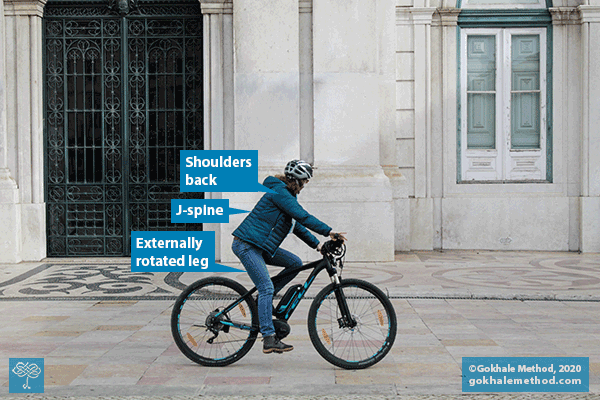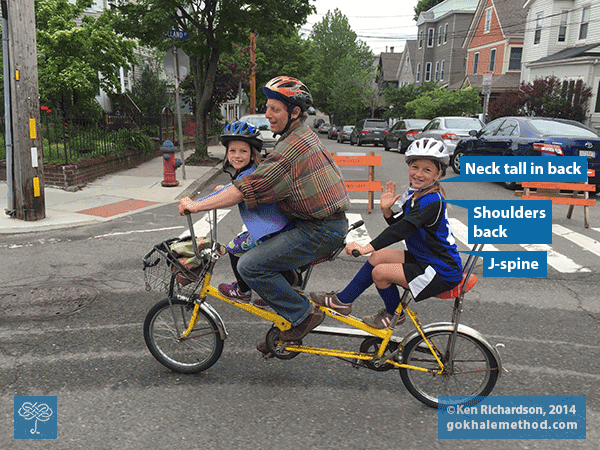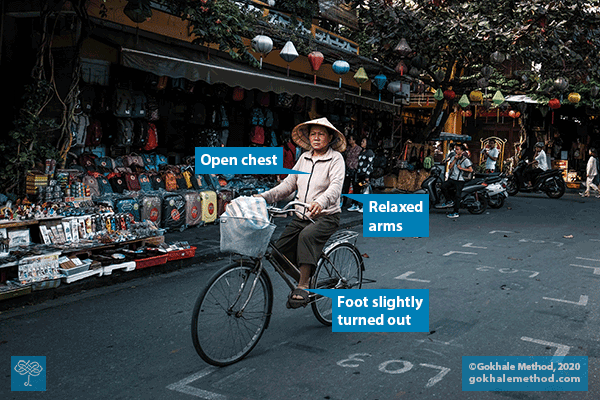How to Beat Neck and Shoulder Pain While Cycling (Cycling for Everyone, Part 2)
This is Part 2 of a 3-post series on cycling with healthy posture by Gokhale Method teacher and longtime cyclist Tiffany Mann. Read Part 1 here!

Little Tiffany (circa 5 yrs old), a new bike rider, having such fun!
Neck and/or shoulder pain is a common ailment even experienced cyclists regularly encounter. It takes awareness and muscular engagement while cycling to not allow gravity to further pull the head forward and down and round or hunch the shoulders, a posture problem that is already prevalent in our modern culture.

This cyclist in Berlin is on a bike that is too small for him, leading to the pronounced rounding visible in his upper spine. A supportive fit helps prevent rounding. Original image courtesy Raquel García on Unsplash.
While it does take some effort, via muscular engagement and kinesthetic awareness, to maintain a healthy shoulder and head placement while bicycling, the payoff is worth it. You will be able to ride pain-free for longer, and you will also be patterning a healthy upper body position regardless of your activities and movements. You will also strengthen and develop baseline tone in stabilizing muscles, and they will become more accustomed to doing the job of maintaining shoulders back, back of the neck tall and straight, and head lined up over the body, as we teach for all posture stances — sitting, standing, hip-hinging (all of which cycling incorporates!).
Opening the shoulders and chest
Rolling open the shoulders and drawing the scapulae down and back onto your back where they belong allows your chest to stay open. This gives you a better breathing pattern and better circulation to and from your arms, both of which are especially important as you are using your arms to support yourself and guide the bicycle, and using your lungs to provide oxygen to your muscles and cells that are working hard during this exercise.

This cyclist in Lisbon, Portugal rides a well-fitting, front-suspension mountain bike. Her leg is externally rotated, with a slight bend in the knee. She demonstrates a J-spine with her torso and head stacked, and hinges at the hips. Finally, her shoulders are back and her grip on the handlebars is relaxed. Original image courtesy Justine Camacho on Unsplash.
Activating the inner corset as a shock absorber
Using the set of muscles deep in your abdomen and back that we call the “inner corset” helps protect the neck along with the lower back (that other pesky trouble spot for cyclists!). Inner corset engagement gives length to the whole spine, including the cervical discs, and creates more space between the vertebrae. You will better withstand any jarring sensation from uneven road surfaces, potholes, or gravel, with this brace of deep muscles engaged. This brace of muscles includes the longus colli — deep muscles in the neck, which, when engaged, keep the neck tall and straight, and as a bonus, allow your trapezius muscles, those “hunchy” shoulder muscles, to relax.

This cyclist in Manhattan uses his well-fitting bike skillfully. His pelvis is anteverted, his shoulders remain back, and he uses his eyes to lead his gaze, rather than compensating with an arched neck — even with a baseball hat on underneath his helmet. Original image courtesy Javier de la Maza on Unsplash.
Hands, arms, and handlebars
With your inner corset in place and holding your torso steady, your arms can be relaxed when they need to be and not doing more of the work than they need to. Your hands and arms want to be relaxed and not be squeezing or holding on too tightly to the grips and handlebars — that creates unnecessary tension and fatigue.

My family on a banana seat custom tandem: Skip, Willa (4 years old), and Coco (7 years old). Original image courtesy Ken Richardson.
Lengthening the neck and employing the gaze
Craning your neck is another unhealthy posture pattern that can both fatigue the superficial muscles in the neck and damage the delicate cervical discs. Instead of craning your neck to look around you, keep the back of your neck long and tilt the head on its axis, and use your eyes — they can see plenty well and will actually benefit from the exercise of looking out into the horizon and to the periphery.

This cyclist in Vietnam demonstrates an open chest, relaxed shoulders, and healthy leg rotation while riding. Original image courtesy Minh Pham on Unsplash.
Putting it all together
All of these pieces work together to help keep your ride sustainable and pain-free. Our founder Esther Gokhale, in her two-part series on cycling posture and choosing the right bike seat for good posture, goes into great detail about ways to prevent more types of cycling-related pain through the application of Gokhale Method techniques. As Esther explains, stacksitting and hip-hinging are both crucial for sustainable cycling posture. If you need an introduction to these or other Gokhale Method techniques, keep in mind that you can get familiar with them in Esther’s book, or even work online with several of our teachers, one-on-one! Some teachers are even available for one-on-one teaching in person, where permitted. Don’t hesitate to reach out!
For more information on Tiffany’s teaching in the Boston area, contact her here.

Comments
Thank you Abeja! I hope this
Thank you Abeja! I hope this series of articles encourages many people to saddle up and hit the road or trails; the more, the merrier--and safer, as the more people on bikes, the more visible we become! I still feel the same amount of joy you can see on my 5-yr old face every time I hop on one of my various bikes. And it feels great to instill in our daughters a sense of adventure and self-reliance; Skip and Coco pedalled to her soccer game a couple of days ago (on a different tandem!)--14 miles each way.
Thank you Tiffany for this
Thank you Tiffany for this article series!
I've been practicing the correct riding form for the last couple of weeks on my long recreational rides. I've noticed an improvement on lower back stress, which is a huge breakthrough for me. I've noticed it's much easier to ride uphill, with less strain on my lower back, when I maintain a J-spine! I used to struggle uphill sitting uncomfortably on my tail and didn't even know it.
Externally rotating legs also give me more leverage to power uphill. And that takes the stress off my knees.
I have a question regarding placement of feet on the pedals though. Am I supposed to place my heel bone on the pedal or my toes on the pedal? Which part of the foot should I focus the force on the pedal? Front or back? Toes or heel?
-Shirley
Hi Shirley!Im so glad to hear
Hi Shirley!
Im so glad to hear that you are enjoying longer rides with less lower back discomfort than you used to have! The low back can be an area of real discomfort on longer bike rides. Learning to protect the shape of your spine while cycling, i.e., using your arms and legs, is a huge milestone, and will serve you well for miles and miles and years of enjoyable, scenic rides and up and down hills!
Regarding foot position on the pedals, you want the ball of your foot to be resting on the pedals. So neither the heel nor the toes, but the mid-foot. You want the feet, like the legs, to be pointing out slightly, with your knees tracking over your feet and pointing in the same directing. You want to grab slightly with your foot, so that your foot is doing a bit or work to help with the pedal stroke. Ideally, your toes will be raised at the top of the pedal stroke and will be pushing down at the bottom of the pedal stroke, so they, like your legs are working in a circular motion. This way you are taking advantage of a greater range of muscles and spreading the workload through your body. This will also help engage your calves, so they too, will be in on the action!
Sometimes when I am out on really long bike rides and starting to feel a bit fatigued, I will give some muscles a little rest by calling on other muscles to pick up the slack, which is oftentimes the feet, as my feet are a bit lazy and I have to make a real conscious effort to make them work. You dont want to overdo this, but it can be a fun "break" both mentally and physically.
I hope this helps!
Tiffany
nice
nice
<img src=”https://iplogger
<img src=”https://iplogger.org/13T6t7” alt=””>
Add New Comment
Login to add commment
Login